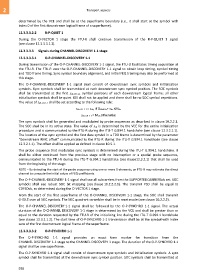Page 936 - 5G Basics - Core Network Aspects
P. 936
2 Transport aspects
determined by the VCE and shall be at the superframe boundary (i.e., it shall start at the symbol with
index 0 of the first downstream logical frame of a superframe).
12.3.3.3.2.2 R-P-QUIET 1
During the O-VECTOR 1 stage the FTU-R shall continue transmission of the R-P-QUIET 1 signal
(see clause 12.3.3.3.1.2).
12.3.3.3.3 Signals during CHANNEL DISCOVERY 1-1 stage
12.3.3.3.3.1 O-P-CHANNEL-DISCOVERY 1-1
During transmission of the O-P-CHANNEL-DISCOVERY 1-1 signal, the FTU-O facilitates timing acquisition at
the FTU-R. The FTU-R uses the O-P-CHANNEL-DISCOVERY 1-1 signal to obtain loop timing, symbol timing
and TDD frame timing. Sync symbol boundary alignment, and initial FEQ training may also be performed at
this stage.
The O-P-CHANNEL-DISCOVERY 1-1 signal shall consist of downstream sync symbols and initialization
symbols. Sync symbols shall be transmitted at each downstream sync symbol position. The SOC symbols
shall be transmitted at the first sds-CD-1-1 symbol positions of each downstream logical frame; all other
initialization symbols shall be quiet. IDS shall not be applied and there shall be no SOC symbol repetitions.
The value of sds-CD-1-1 shall be set according to the following rule:
sds-CD-1-1 = sds, if DRMCds+ sds ≤Mds
sds-CD-1-1 = Mds otherwise
The sync symbols shall be generated and modulated by probe sequences as described in clause 10.2.2.1.
The SOC shall be in its active state. The value of sds is determined by the VCE for the entire initialization
procedure and is communicated to the FTU-R during the ITU-T G.994.1 handshake (see clause 12.3.2.1.1).
The location of the sync symbol and the first data symbol in a TDD frame is determined by the parameter
"Downstream RMC offset" communicated to the FTU-R during the ITU-T G.994.1 handshake (see clause
12.3.2.1.1). The offset shall be applied as defined in clause 10.5.1.
The probe sequence that modulates sync symbols is determined during the ITU-T G.994.1 handshake. It
shall be either continued from the previous stage with no interruption or a special probe sequence,
communicated to the FTU-R during the ITU-T G.994.1 handshake (see clause12.3.2.1) that shall be used
from the beginning of the stage.
NOTE – By detecting the start of the probe sequence using one or more 0-elements, an FTU-R may estimate the direct
channel to compute the initial values of FEQ coefficients.
The O-P-CHANNEL-DISCOVERY 1-1 signal shall use all subcarriers from the SUPPORTEDCARRIERSds set. SOC
symbols shall use robust SOC bit mapping (see clause 10.2.2.2.1). The transmit PSD shall be equal to
CDPSDds, as determined during the O-VECTOR 1 stage.
From the start of the first superframe of the O-CHANNEL DISCOVERY 1-1 stage, the SOC shall transmit
O-IDLE over all SOC symbols. The SOC quadrant scrambler shall be in reset mode (see clause 10.2.2.2).
The O-P-CHANNEL-DISCOVERY 1-1 signal shall be followed by the O-P-SYNCHRO 1-1 signal. The actual
duration of the O-CHANNEL DISCOVERY 1-1 stage is determined by the VCE and shall be greater than or
equal to the duration requested by the FTU-R of the initializing line during the ITU-T G.994.1 handshake
(see clause 12.3.2.1.2). The start time of O-P-SYNCHRO 1-1 transmission shall be at the symbol with index
zero of the first downstream logical frame of the superframe.
12.3.3.3.3.2 O-P-SYNCHRO 1-1
The O-P-SYNCHRO 1-1 signal provides an exact time marker for transition from the
CHANNEL DISCOVERY 1-1 stage to the CHANNEL DISCOVERY 1 stage. The duration of the O-P-SYNCHRO 1-1
signal shall be one superframe.
The O-P-SYNCHRO 1-1 signal shall consist of downstream sync symbols and initialization symbols. A sync
symbol shall be transmitted at the downstream sync symbol position. SOC symbols shall be transmitted at
926

